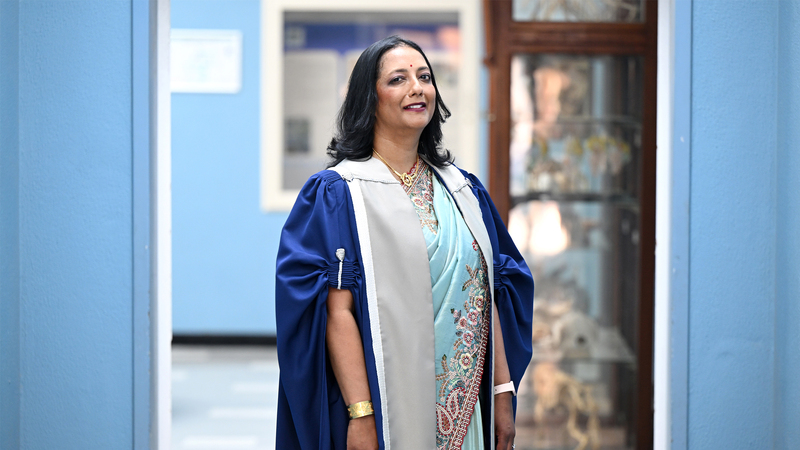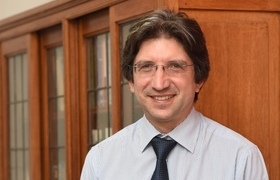Finding magic in the path less travelled
06 November 2025 | Story Myolisi Gophe. Photos Lerato Maduna. Read time 7 min.
When Professor Komala Pillay from the University of Cape Town’s (UCT) Faculty of Health Sciences stepped up to deliver her inaugural lecture on 30 October, she invited her audience to see science through a different lens – one that values curiosity, courage, and compassion as much as precision.
Titled “Give the Path Less Travelled a Chance – It May Turn Out to Be Magical”, the lecture traced Professor Pillay’s unlikely, sometimes winding route, into anatomical pathology – a field that, though often underappreciated, forms the backbone of modern medicine. It was a journey illuminated by mentors, colleagues, students, and patients who taught her that magic can be found in even the smallest cells.
Pillay’s fascination with medicine began in childhood, inspired by stories her father told of a young woman from their Durban neighbourhood who became a paediatric doctor. “I was captivated by that story,” she recalled. “It planted a seed that one day grew into purpose.” A school visit to the then University of Natal, where Professor Ronnie Green-Thompson addressed students, sealed her determination to pursue medicine.
As a third-year medical student, she encountered the mysterious, meticulous world of anatomical pathology. “I spent my spare time in the labs learning to cut and stain sections, to interpret the pink-and-blue patterns under the microscope that reveal a patient’s diagnosis,” she said. “It felt like unlocking a language only the body could speak.”
That early curiosity led to her first research projects, including an investigation into tumour suppressor proteins such as p53 and bcl2 in a childhood cancer, rhabdomyosarcomas, work that later informed modern prognostic studies.
From student to leader
Today, Pillay holds the Wernher and Beit Chair of Pathology and leads the Division of Anatomical Pathology at both UCT and the National Health Laboratory Service (NHLS), serving Groote Schuur and Red Cross War Memorial Children’s hospitals. She is also an honorary professor at Walter Sisulu University, a distinction that reflects her national and continental influence.
Her academic journey, spanning the University of KwaZulu-Natal, UCT, the Colleges of Medicine of South Africa, and the Royal College of Pathologists in the United Kingdom (UK), integrates clinical service, research, and teaching. She has published more than 100 peer-reviewed papers across oncology, neuropathology, placental pathology, lymphoma, and infectious diseases, while mentoring numerous postgraduate students who now lead laboratories across South Africa.
Recounting her early career, Pillay recalled the intense rhythm of the pathology registrar years. “You quickly learn that turnaround time is everything,” she said. “Service first, then everything else, because every report waiting on your desk represents a patient waiting for answers.”
Her blend of service and scholarship became evident in her landmark research on HIV transmission through the placenta, which revealed how specific cellular receptors increase in HIV-positive mothers even on antiretroviral therapy. This project, she said, taught her the power of persistence and collaboration – a five-minute conversation with the head of Obstetrics and Gynaecology opened doors that months of bureaucracy had kept closed.
That spirit of curiosity has since shaped her collaborations with South African and UK researchers, and together they have produced influential studies on maternal and neonatal health.
Seeing meaning in every slide
At the Red Cross War Memorial Children’s Hospital, Pillay’s appreciation for cytopathology – the study of whole cells under the microscope – deepened. “Looking at cells without prior sectioning can be magical,” she said. “You’re seeing life at its most direct level.” From urgent intra-operative diagnoses to fine-needle aspiration biopsies that spare children invasive surgery, her work underscores how microscopic precision can translate into profound human impact.
“That’s the real magic: when science changes a family’s story.”
Among her most memorable cases was a muscle biopsy of a newborn that was non-diagnostic under light microscopy but, when examined under electron microscopy, revealed crystalline abnormalities linked to a rare actin gene mutation. “That discovery allowed doctors to investigate for the same condition in the mother’s next pregnancy,” she said. “That’s the real magic: when science changes a family’s story.”
Her team has also made pioneering diagnoses in mitochondrial disorders and paediatric tumours and developed novel staining techniques to detect bacterial biofilms in infant tissue – a simple yet lifesaving innovation recognised at national conferences.
Appointed head of the division in 2020 at the height of the COVID-19 pandemic, Pillay’s first mission was, she joked, “to survive the year”. But she did more than that: she reconfigured pathology teaching for online learning, maintained essential diagnostic services under immense pressure, and expanded research networks across the continent.
“Sometimes you think small changes will make a big difference,” she said. “But I’ve learned that to create lasting impact, we must also be bold – take big steps to make big changes.”
Under her leadership, UCT and the NHLS are advancing digital pathology and molecular diagnostics to bring cutting-edge technology into the public health sector. Pillay also chairs the NHLS Anatomical Pathology Expert Committee, serves as president of the College of Pathologists of South Africa, and advises the Royal College of Pathologists in the UK, and the Ministerial Advisory Committee for the Prevention and Control of Cancer.
Mentorship and magic
Throughout her lecture, Pillay acknowledged the mentors, technologists, and clinicians who shaped her path – from Professor Paul Willcox, who treated her tuberculosis during her early Cape Town years, to laboratory colleagues whose skill and humour carried her through long hours at the microscope. “Our work is a team sport,” she said. “Each discovery belongs to all of us.”
She urged young scientists to find mentors who see potential before it fully reveals itself. “Be patient with yourself,” she told them. “The path less travelled is rarely easy, but every detour teaches you something essential.”
As she closed her lecture, Pillay reflected on the evolving role of pathology in Africa and the next generation of scientists rising behind her. “I feel enormous hope when I see the energy of young pathologists,” she said. “They’re proving that excellence and service can thrive in the public sector.”
 This work is licensed under a Creative Commons Attribution-NoDerivatives 4.0 International License.
This work is licensed under a Creative Commons Attribution-NoDerivatives 4.0 International License.
Please view the republishing articles page for more information.














